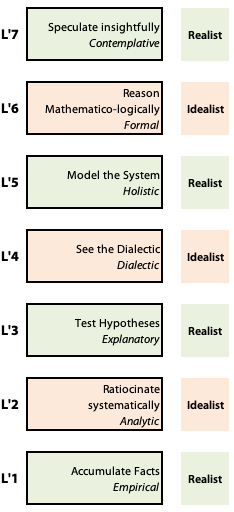Idealism and Realism
Perennial Duality
Research methods attempt to generate Truth with certainty. Truth here refers to the fullest correspondence between representations and realities within a field of interest.
In addressing the best way to reveal or produce the Truth, philosophers have long been aware of two unavoidably conflicting perspectives: idealist and realist.
This perennial conflict within metaphysics and epistemology, like all great philosophical questions, remains unresolved. The resolution offered here is the idea that we are dealing with an oscillating duality.

The duality identified here is: Scientific Realism v Epistemic Idealism.
The Scientific Realist position holds that there is a real world independent of what we might take it to be; and it is the awareness of that world that drives all inquiry and governs findings.
Scientific realism is the foundation of all inquiry and knowledge, but users of this perspective do not deny the value of ideas, nor do they necessarily reject the reality of mental (i.e. non-physical) entities or events.
The Epistemic Idealist position holds that the presence and power of ideas or ideal entities (like assumptions, values, concepts &c) must and should predominate in inquiry and shape any grasp of reality.
Epistemic idealism does not necessarily deny or reject the position of scientific realism, but users of this perspective are unwilling to depend on a realist position in their choice of .
Dominance: The realist perspective is dominant in that it characterizes the 4 odd-numbered levels, while the idealist perspective characterizes the 3 even-numbered levels.
Scientific Realism
L'1-Empirical Method
Reality determines representations directly via a simple consensus on its sensed features.![]() More
More
L'3 Explanatory Method
Reality is the testing ground for ideas. It will give pointers and answers, often partial or temporary, in response to suitable simple questions.![]() More
More
L'5-Holistic Method
Reality is primary because it exists to be changed and that involves recognizing that it is socio-physical i.e. it includes people with their intentions and meanings dealing with tangible resources in a physical environment. ![]() More
More
L'7-Contemplative Method
Only a profound identification with actual reality will lead to an acceptable replacement of its currently unsatisfactory representation.![]() More
More
Epistemic Idealism
Conceptual clarity and frameworks of ideas are necessary before reality can be sensibly investigated and represented using any method.![]() More
More
Polarised ideas need identification and clarification because they both obscure reality and indicate a deeper unifying reality that requires representation.![]() More
More
Ideas can be made absolutely precise and certain, and their development is controllable by positing rules of logic. This enables sharing and manipulation of those ideas regardless of the actual state of reality.![]() More
More
- See a similar duality within the decision-making typology: functional idealism v practical realism.
- Then compare controls for and .
- Compare all research methods simultaneously via a TET.
Originally drafted: 19-Apr-2015. Last amended 21-Feb-2022.